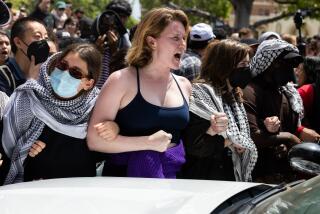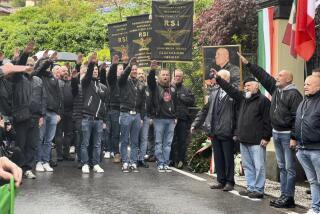Protest Marches Are the Cat’s Meow Throughout Italy
- Share via
ROME — Under the shadow of the Colosseum marched the cat ladies, protest banners in the air, kittens in their handbags.
Free neutering! the merry mob demanded. Give us a Rome where our cats can roam!
Yes, the 2,000-strong kitten crew who marched for “Cat Pride” last weekend had a cause. No, it wasn’t about to shake the world. But here in Italy, just about any cause is cause for a rally, from major issues to personal fancies, even feline ones.
Cat march organizer Matilde Talli says anything can be an occasion for protest so long as it moves you.
“Causes are important because you feel them,” she said. “We feel this.”
The protest trend in Italy has increased in recent years, whether it’s a couple of pickets over rising rent or a million marching against war with Iraq. This was brought home Feb. 15, a day of global antiwar demonstrations, when Rome drew the world’s single biggest rally.
And it wasn’t the only massive Italian march in recent months. At least a million protested a labor law in April, and about 500,000 protested in Florence in November against globalization.
In 2000 -- partly inspired by 1999 protests in Seattle -- rowdy marchers devastated Genoa during a Group of Eight summit. One demonstrator was killed by police.
A Roman police official said keeping count of all demonstrations is tough, but he insisted that from tiny protests to vast marches, it adds up to “at least two a day” in the capital.
One expert sees a boom in the last two years.
“In Italy, there had been quite a tradition of protest, especially labor movements, but it was not the case for about the last two decades,” said Donatella Della Porta, a political science professor at the University of Florence. “This tradition is now revitalized.”
“In part, it is Italy; in part, it is this period. The peace protests were impressive almost everywhere in Europe -- there is a return to politics from below,” she said.
Protests swept Italy in 1968, as they did across Western Europe. In the ‘70s, protesters radicalized, with a few turning to political terrorism. But by the mid-1980s, mass protests had largely died out.
In Italy, the protest renaissance is rooted in the 1990s, said Della Porta, when bribery scandals wiped out leading Italian political parties and prompted a disdain for officials.
One key element for the leftists who make up most of the current protesters is their distaste for the government of Premier Silvio Berlusconi. They’re also annoyed at their own political leaders, whom they often characterize as weak.
Labor unions play a major role, too, with millions of adherents and a tendency to take stands on all sorts of issues. Strikes are a part of daily life in Italy, staged by everyone from cabbies and journalists to airline pilots and factory workers.
Donata Francescato, a psychologist of communities at the University of Rome, says Italians have a tendency to turn issues into public activism.
“In America, you write a letter to your representative. In Italy, there’s a strong history of demonstrations in our squares -- we have beautiful squares everywhere; they’ve always been a place of meeting, to get together and discuss things.”
Columnist Augusto Minzolini of La Stampa newspaper noted that many Italian marches have a festive atmosphere.
“It’s a way of being like a tribe,” Minzolini said. “On the one side, you have the church and the basically thousands or more who gather on Sundays in front of the Vatican. On the other side, you have people who say that their credo, their liturgy, is taking to the streets.”
The cat ladies’ credo was kitty pride, but they had their complaints, mostly that they -- not the city -- take care of Rome’s thousands of strays.
And if officials ignore them? The cat ladies promised that they’d be back to emphasize another kind of protest: Cats don’t vote, but we do.
More to Read
Sign up for Essential California
The most important California stories and recommendations in your inbox every morning.
You may occasionally receive promotional content from the Los Angeles Times.










